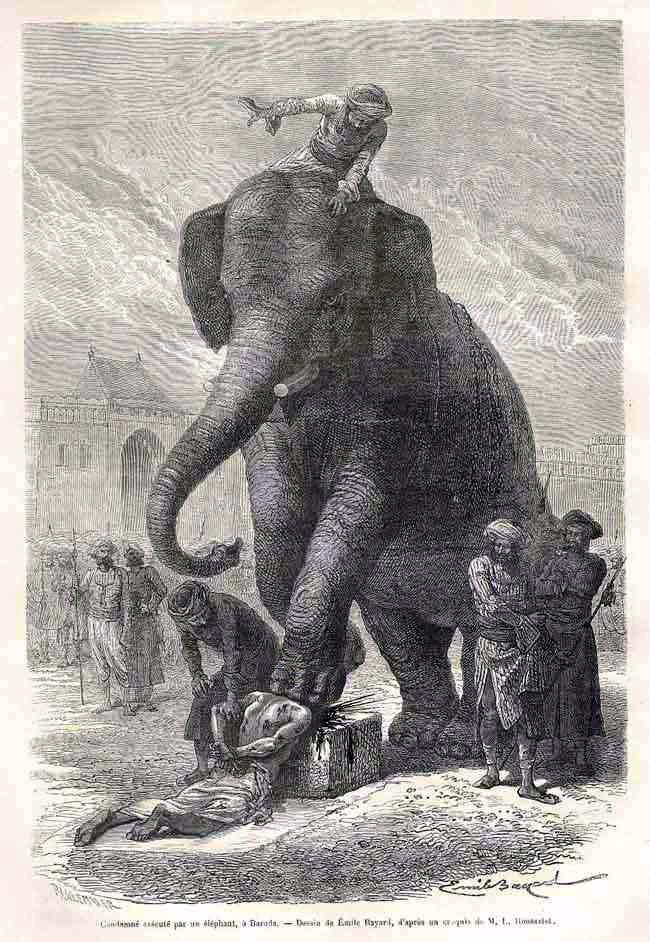Execution by Elephant July 21, 2010
Author: Beach Combing | in : Ancient, Medieval, Modern , trackback
And so begins Elephant Week – for the next seven evenings an article will be given over to the freakish fringe history of the largest land mammal.
First of all, this extraordinary passage from the work of Louis Rousselet, India and its Native Princes (1882). In chapter ten of India – first published as L’Inde des Rajahs: Voyage Dans l’Inde Centrale in 1875 – Rousselet describes his visit to Baroda (Vadodara) in north-western India.
In an attempted revolt by the Waghurs, ‘a half civilised and very warlike race’, a local locksmith was found guilty of helping Waghur prisoners to escape: ‘and the unhappy locksmith was condemned to the punishment of death by the [sic] elephant’.
This punishment is one of the most frightful that can possibly be imagined. The culprit, bound hand and foot, is fastened by a long cord, passed round his waist, to the elephant’s hind leg. The latter is urged into a rapid trot in the streets, and every step gives the cord a violent jerk, which makes the body of the condemned wretch bound on the pavement. The only hope that remains for the unhappy man is to be killed by one of these shocks; if not, after traversing the city, he is released, and, by a refinement of cruelty, a glass of water is given him. Then his head is placed upon a stone, and the elephant executioner crushes it beneath his enormous foot. (p.119)
The civilised Raj? This is enough to have Amnesty reaching for a thousand telephones.
But death by elephant was once relatively common in areas where elephants had been domesticated.
Typically, there were two forms.
(i) As here a specially-trained elephant executioner was sent in to trample or crush the condemned. Maccabees 3, for example, describes death by elephant in Egypt in the third century B.C. In fact, there is reason for thinking that the lock-smith got off lightly. In some sub-continental states elephant executioners were expected to prolong the suffering of the prisoner by throwing him in the air or by crushing the limbs before going in for the kill.
(ii) In medieval India, under the sultans, elephants, instead, employed blades to kill the condemned.
The elephants which execute men have their tusks covered with sharp irons with edges like those of knives. The drivers mounts the elephant, and, when a person is thrown in front, the animal winds his trunk round him, hurls him into the air, and catching him on one of his tusks, dashes him to the ground, when he places one of his feet on the breast of the victim. After this he does as he is directed by the rider, under the order of the Sultan. If the Sultan desires the culprit to be cut in pieces, the elephant executes the command by means of the irons above described; if the Sultan desires the victim to be left alone, the elephant leaves him on the ground, and (the body) is then stripped of its skin [not presumably by the elephant: B]’ Dowson in Kistler 200)
Talk about ‘cruel and unusual’.
When did execution by elephant finally die out in Asia? Beachcombing fears the twentieth century, though he has no proof. yet… drbeachcomingATyahooDOTcom
(Note that the illustration that heads the present piece came from the pen of Emile Bayard, was based on Rousselet’s experiences at Baroda and was published in Le Tour du Monde, 1868. Rousselet was an enthusiastic photographer. Is it possible that…)
Elephant Week is dedicated to Beachcombing’s dear friend and notable elephant lover Raoul who helped the Beachcombings put up a curtain rail a few days ago.



